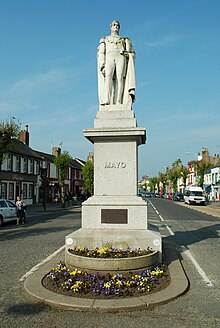Richard Bourke, 6th Earl of Mayo
Henry Arthur Herbert | |||||||||||||||||||||||
|---|---|---|---|---|---|---|---|---|---|---|---|---|---|---|---|---|---|---|---|---|---|---|---|
| Succeeded by | Edward Cardwell | ||||||||||||||||||||||
| In office 1 March 1852 – 17 December 1852 | |||||||||||||||||||||||
| Prime Minister | The Earl of Derby | ||||||||||||||||||||||
| Preceded by | Sir William Somerville, Bt | ||||||||||||||||||||||
| Succeeded by | Sir John Young, Bt | ||||||||||||||||||||||
| |||||||||||||||||||||||
| Personal details | |||||||||||||||||||||||
| Born | Richard Southwell Bourke 21 February 1822 Dublin, Ireland | ||||||||||||||||||||||
| Died | 8 February 1872 (aged 49) Port Blair, Andaman Islands, India | ||||||||||||||||||||||
| Manner of death | Assassination | ||||||||||||||||||||||
| Nationality | British | ||||||||||||||||||||||
| Political party | Conservative | ||||||||||||||||||||||
| Spouse |
Hon. Blanche Wyndham
(m. 1848) | ||||||||||||||||||||||
| Children | Trinity College, Dublin | ||||||||||||||||||||||
Richard Southwell Bourke, 6th Earl of Mayo,
Background and education
Mayo was born in
Political career

After travelling in Russia, Mayo was elected
Assassination
While visiting the convict settlement at Port Blair in the Andaman Islands in 1872 for the purpose of inspection, he was assassinated by Sher Ali Afridi, a former Afghan soldier who had been convicted for murdering a relative. He vowed to kill two British officials to avenge the suffering he had to undergo. Mayo's body was brought home to Ireland and buried at the medieval ruined church in Johnstown, County Kildare, near his home at Palmerstown House. Afridi was hanged on March 11, 1872.[5]
Memorials
Lord Mayo March
The traditional Irish march "Lord Mayo" (Tiagharna Mhaighe-eo) was named after him; according to tradition, it was composed by his harper David Murphy to appease Mayo after Murphy angered him.[6]
Papilio mayo Butterfly
In 1873, the newly discovered swallowtail butterfly Papilio mayo from the Andaman Islands was named in his honour.[7]
St Paul's Cathedral
A Memorial to Lord Mayo is in the third recess of the South Wall at St Paul's Cathedral, London.[8]
Statue in Cockermouth, Cumbria

On 19 August 1875, a statue of Lord Mayo was unveiled in the centre of the main street in the town of
. The statue, carved in Sicilian marble, depicts Lord Mayo in his viceregal garb, and still stands today.Mayo Hospital, Lahore, Pakistan
Statue at Albert Hall Museum, Jaipur, India
A statue of Lord Mayo had been installed in the premises of Mayo Hospital (currently known as the Mahilya Chikatsalya, Jaipur). The 9-foot-tall (2.7 m) cast-iron statue, weighing around 3 tons, was ordered sculpted by the Maharaja Ram Singh ji of Jaipur, as a tribute to Lord Mayo after his assassination. The sculptors were J. Forsyth and R. Monti. The company's name as inscribed on the statue was R. Masefield & Co., London.
This statue of Lord Mayo had been buried in the premises of the Albert Hall Museum of Jaipur at the time of the independence of India in 1947 to prevent vandalism. After six decades, this statue was unearthed by the Jaipur Mayo Alumni Chapter on 29 May 2007. It was later removed from the Albert Hall Museum in Jaipur and sent to Mayo College, in Ajmer, India, where it is now installed.[9]
Mayo College, Ajmer, India
Mayo College, Ajmer, India, was founded after the death of Lord Mayo in 1875. The College, named in honour of Lord Mayo, already had a full life-size statue of him sculpted in white marble installed in front of its famous main building since inception and a marble sculpted bust of him in its school museum. The College accepted the statue of Lord Mayo which was unearthed at Mayo Hospital, Jaipur in 2007.
Family
Lord Mayo married Blanche Julia, daughter of
Arms

|
|
See also
- Mayo College, Ajmer, India
- Mayo Hall, Allahabad, India
- Mayo Hall, Bangalore, India
- Mayo School of Arts, Lahore, British India
- Viceroy of India
- Mayo Hospital, Lahore, Pakistan
Notes
- ISBN 978-1-84664-774-1.
- Thomas Ulick Sadleirp84: Dublin, Alex Thom and Co, 1935
- ^ Riding Recollections, 5th ed. by G. J. Whyte-Melville. Pages 136-139. Accessed 5 September 2022.
- ^ Stephen, Leslie, ed. (1886). . Dictionary of National Biography. Vol. 6. London: Smith, Elder & Co.
- ^ 1872: Sher Ali Afridi, assassin of the viceroy
- ^ S.J. Adair Fitzgerald (1898). Stories of Famous Songs. John C. Nimmo. p. 380.
- ^ Atkinson, W.S. (1873). "Descriptions of two new species of butterflies from the Andaman Islands". Proceedings of the Zoological Society of London. 1873: 736.
- Sinclair, W.p. 462: London; Chapman & Hall, Ltd; 1909.
- ^ Annual Register Two statues of Lord Mayo have also been placed in Mayo College, Ajmer – One outside its main building and the other outside its museum. pp. 74–75.
- ISBN 0-9711966-2-1.
- ^ Burke, Bernard (1884). The general armory of England, Scotland, Ireland, and Wales; comprising a registry of armorial bearings from the earliest to the present time. University of California Libraries. London : Harrison & sons.
References
- "Bourke, Richard Southwell". doi:10.1093/ref:odnb/2998. (Subscription or UK public library membershiprequired.)
- Pottinger, George. Mayo: Disraeli's Viceroy (Michael Russell, 1990) ISBN 978-0-85955-164-9
- Annual Register: A Review of Public Events at Home and Abroad for the Year 1875. London: Rivingtons.
- Kidd, Charles, Williamson, David (editors). Debrett's Peerage and Baronetage (1990 edition). New York: St Martin's Press, 1990, [page needed]
- Encyclopædia Britannica Article on Richard Southwell Bourke, 6th earl of Mayo
- Obituary & Photo at the Mayo College, Ajmer, India website
External links
 Media related to Richard Bourke, 6th Earl of Mayo at Wikimedia Commons
Media related to Richard Bourke, 6th Earl of Mayo at Wikimedia Commons
